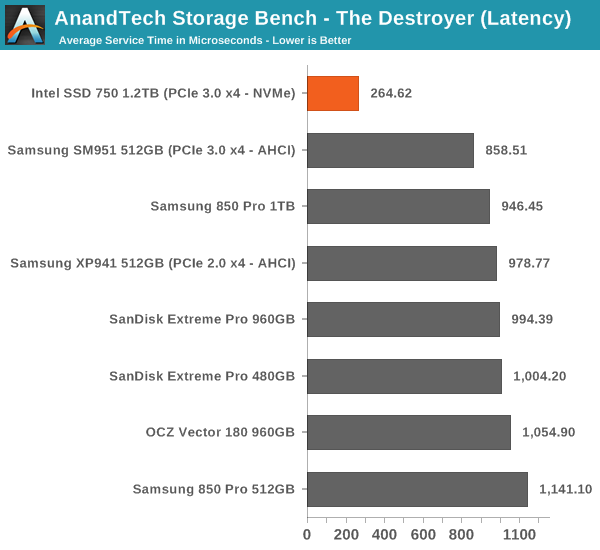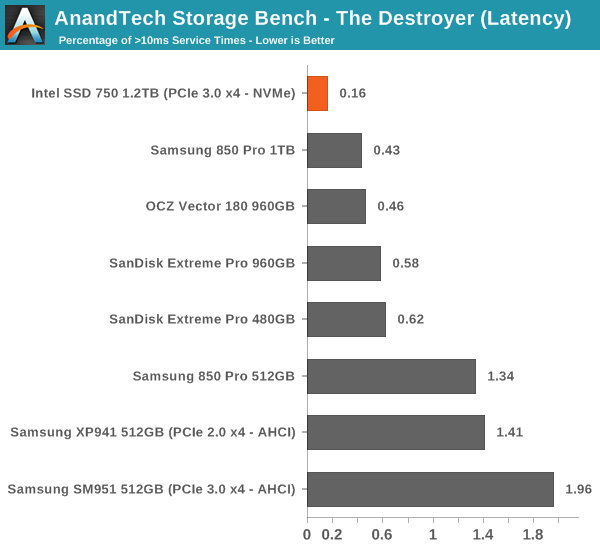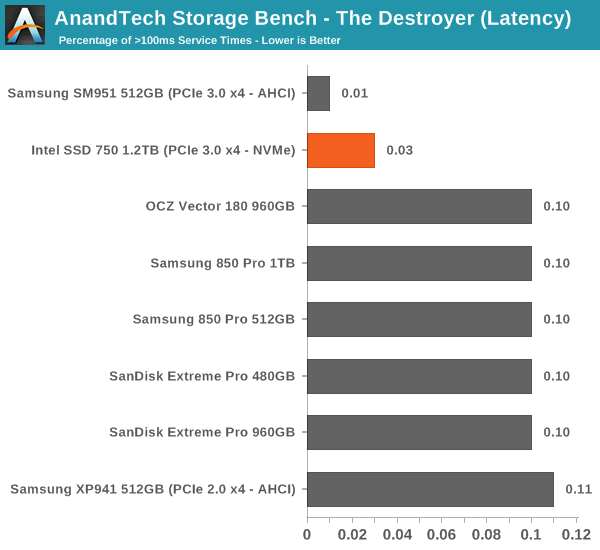Intel SSD 750 PCIe SSD Review: NVMe for the Client
by Kristian Vättö on April 2, 2015 12:00 PM ESTAnandTech Storage Bench - The Destroyer
The Destroyer has been an essential part of our SSD test suite for nearly two years now. It was crafted to provide a benchmark for very IO intensive workloads, which is where you most often notice the difference between drives. It's not necessarily the most relevant test to an average user, but for anyone with a heavier IO workload The Destroyer should do a good job at characterizing performance.
| AnandTech Storage Bench - The Destroyer | ||||||||||||
| Workload | Description | Applications Used | ||||||||||
| Photo Sync/Editing | Import images, edit, export | Adobe Photoshop CS6, Adobe Lightroom 4, Dropbox | ||||||||||
| Gaming | Download/install games, play games | Steam, Deus Ex, Skyrim, Starcraft 2, BioShock Infinite | ||||||||||
| Virtualization | Run/manage VM, use general apps inside VM | VirtualBox | ||||||||||
| General Productivity | Browse the web, manage local email, copy files, encrypt/decrypt files, backup system, download content, virus/malware scan | Chrome, IE10, Outlook, Windows 8, AxCrypt, uTorrent, AdAware | ||||||||||
| Video Playback | Copy and watch movies | Windows 8 | ||||||||||
| Application Development | Compile projects, check out code, download code samples | Visual Studio 2012 | ||||||||||
The table above describes the workloads of The Destroyer in a bit more detail. Most of the workloads are run independently in the trace, but obviously there are various operations (such as backups) in the background.
| AnandTech Storage Bench - The Destroyer - Specs | ||||||||||||
| Reads | 38.83 million | |||||||||||
| Writes | 10.98 million | |||||||||||
| Total IO Operations | 49.8 million | |||||||||||
| Total GB Read | 1583.02 GB | |||||||||||
| Total GB Written | 875.62 GB | |||||||||||
| Average Queue Depth | ~5.5 | |||||||||||
| Focus | Worst case multitasking, IO consistency | |||||||||||
The name Destroyer comes from the sheer fact that the trace contains nearly 50 million IO operations. That's enough IO operations to effectively put the drive into steady-state and give an idea of the performance in worst case multitasking scenarios. About 67% of the IOs are sequential in nature with the rest ranging from pseudo-random to fully random.
| AnandTech Storage Bench - The Destroyer - IO Breakdown | |||||||||||
| IO Size | <4KB | 4KB | 8KB | 16KB | 32KB | 64KB | 128KB | ||||
| % of Total | 6.0% | 26.2% | 3.1% | 2.4% | 1.7% | 38.4% | 18.0% | ||||
I've included a breakdown of the IOs in the table above, which accounts for 95.8% of total IOs in the trace. The leftover IO sizes are relatively rare in between sizes that don't have a significant (>1%) share on their own. Over a half of the transfers are large IOs with one fourth being 4KB in size.
| AnandTech Storage Bench - The Destroyer - QD Breakdown | ||||||||||||
| Queue Depth | 1 | 2 | 3 | 4-5 | 6-10 | 11-20 | 21-32 | >32 | ||||
| % of Total | 50.0% | 21.9% | 4.1% | 5.7% | 8.8% | 6.0% | 2.1% | 1.4% | ||||
Despite the average queue depth of 5.5, a half of the IOs happen at queue depth of one and scenarios where the queue depths is higher than 10 are rather infrequent.
The two key metrics I'm reporting haven't changed and I'll continue to report both data rate and latency because the two have slightly different focuses. Data rate measures the speed of the data transfer, so it emphasizes large IOs that simply account for a much larger share when looking at the total amount of data. Latency, on the other hand, ignores the IO size, so all IOs are given the same weight in the calculation. Both metrics are useful, although in terms of system responsiveness I think the latency is more critical. As a result, I'm also reporting two new stats that provide us a very good insight to high latency IOs by reporting the share of >10ms and >100ms IOs as a percentage of the total.

In terms of throughput, the SSD 750 is actually marginally slower than the SM951, although when you look at latency the SD 750 wins by a large margin. The difference in these scores is explained by Intel's focus on random performance as Intel specifically optimized the firmware for high random IO performance, which does have some impact on the sequential performance. As I've explained above, data rate has more emphasis on large IO size transfers, whereas latency treats all IOs the same regardless of their size.

The number of high latency IOs is also excellent and in fact the best we have tested. The SSD 750 is without a doubt a very consistent drive.












132 Comments
View All Comments
magreen - Thursday, April 2, 2015 - link
darkgreen, are you talking about a G1 without TRIM or a G2 with TRIM support?darkgreen - Friday, April 3, 2015 - link
I had a G1 without TRIM. The Intel fix was based on some ancient shareware (FreeDOS!) that wouldn't work with many modern motherboards and in some cases left drives bricked. It was well reported at the time (see my comment above for a google search that returns articles), but lots of people wound up with X25-Ms that were useless. If you weren't an enterprise customer the Intel response was "tough luck." No refunds, no replacements, nothing. In all fairness I'm sure Intel would love to be able to support consumers, but they probably aren't set up for it in their storage area because it's just not a big area of their business bottom line.magreen - Sunday, April 5, 2015 - link
Yeah, it seems like the G1 owners got screwed. (I have a G2 and G3 and they've both been great. Sorry they screwed the early adopters.)In Anand's words from 2009 when the G2 was released:
"TRIM isn’t yet supported, but the 34nm drives will get a firmware update when Windows 7 launches enabling TRIM. XP and Vista users will get a performance enhancing utility (read: manual TRIM utility). It seems that 50nm users are SOL with regards to TRIM support. Bad form Intel, very bad form."
http://anandtech.com/show/2806
"Overall the G2 is the better drive but it's support for TRIM that will ultimately ensure that. The G1 will degrade in performance over time, the G2 will only lose performance as you fill it with real data. I wonder what else Intel has decided to add to the new firmware...
I hate to say it but this is another example of Intel only delivering what it needs to in order to succeed. There's nothing that keeps the G1 from also having TRIM other than Intel being unwilling to invest the development time to make it happen. I'd be willing to assume that Intel already has TRIM working on the G1 internally and it simply chose not to validate the firmware for public release (an admittedly long process). But from Intel's perspective, why bother?
Even the G1, in its used state, is faster than the fastest Indilinx drive. In 4KB random writes the G1 is even faster than an SLC Indilinx drive. Intel doesn't need to touch the G1, the only thing faster than it is the G2. Still, I do wish that Intel would be generous to its loyal customers that shelled out $600 for the first X25-M. It just seems like the right thing to do. Sigh."
http://www.anandtech.com/show/2829/11
Redstorm - Thursday, April 2, 2015 - link
Could you elaborate on this (although there appears to be an NVMe version too after all) of the SM951. As looking at the numbers if NVMe even slightly improves the SM951 it would make it a better choice, and the form factor being M.2 makes it much more attractive.Kristian Vättö - Thursday, April 2, 2015 - link
Ganesh received an NVMe version of the SM951 inside a NUC and I've also heard from other sources that it exists. No idea of its retail availability, though, as RamCity hadn't heard about it until I told them.eddieobscurant - Thursday, April 2, 2015 - link
if i'm not wrong the nvme version has p/n MZVPV256HDGL-00000 for the 256gb model while the ahci version has p/n MZHPV256HDGL-00000Redstorm - Friday, April 3, 2015 - link
Thanks looks promising , found this with verbage suposidly from RAMCity that they will ship in May.http://translate.google.co.nz/translate?hl=en&...
Redstorm - Friday, April 3, 2015 - link
So no real proof that they exist then.eddieobscurant - Thursday, April 2, 2015 - link
Kristian, there is a DRAM difference between the two models. The 400gb has 1gb DRAM while the 1.2tb model has 2gb. Do you think it plays a big role in terms of performance between the two models.Also is there a way to reduce the overprovision in these drives? I would prefer 80gb more on the 400gb model over less consistency.
When will you review the kingston hyperX predator, and when will samsung release the sm951 nvme? Q3 or sooner?
KAlmquist - Thursday, April 2, 2015 - link
The 400gb model shouldn't need as much DRAM because it has fewer pages to keep track of. But there's no way to know how the 400gb model will perform until Intel sends out samples for review.